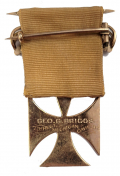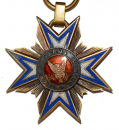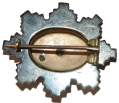site search
online catalog
TIFFANY GOLD CUSTER MEDAL, SHERIDAN CAVALRY BADGE, NUMBERED MOLLUS MEDAL OF COL. GEORGE BRIGGS, 7TH MICHIGAN CAVALRY, WITH A PHOTO OF BRIGGS WEARING THEM, AND WITH HIS 7th MICHIGAN CAVALRY VETERAN’S RIBBON

$19,500.00
Quantity Available: 1
Item Code: 1270-01
Shipping: Determined by Method & Location of buyer
To Order:
Call 717-334-0347,
Fax 717-334-5016, or E-mail
It is hard to think of Civil War medal grouping that equals, let alone surpasses, this one for quality, rarity, visual appeal, historic significance and tight provenance, having descended directly in the Briggs family until 2013. It also carries some strong romantic appeal as the personal design of General George Armstrong Custer and was awarded, or at least approved, only by his person direction. Briggs served in the 7th Michigan Cavalry, an original part of Custer’s Michigan Cavalry Brigade from the regiment’s organization in Fall 1862 to its muster out in December 1865, rising from Lieutenant to Colonel and the regiment’s final commanding officer. His 1912 obituary credited him with participation in 56 engagements and his career mirrored that of the 7th Michigan Cavalry, the Michigan Cavalry Brigade, and Custer, which needs no detailed recital here, but included service in the cavalry corps of the Army of the Potomac, in the Army of the Shenandoah in later 1864, then again with the Army of the Potomac up through Appomattox, where Briggs played a key role and was the officer who received the flag of truce carried into Union lines by Confederate officers seeking the cessation of hostilities that signaled the end of the war. It was thus fitting that this grouping, on loan from a private collection, was on display for the last decade at the Appomattox museum. We are proud to offer this set, an extremely rare opportunity for the collector.
The highlight of the grouping is obviously the very high quality Custer medal, sometimes designated the “Custer Valor Medal” or the “Custer Badge” as referred to by Custer himself, and is to be distinguished from badges worn more generally by members of his command, for it was not only designed by Custer, but commissioned by him from Tiffany in Fall 1864 with the restriction that it would only be issued to specific people at his request. It thus joins a very few other private awards for valor and distinguished service such as the Kearny Medal, Kearny Cross, and the Butler and Gilmore medals that supplemented the only government award- the Congressional Medal of Honor- but is far rarer than any of them. Fewer than a half-dozen are known. Tiffany records shed no light on the matter and just two of Custer’s orders to Tiffany exist: a 15 October 1864 order for one for Lt. Wallace and a 5 January 1865 order for another for Col. Hastings, both of the 5th Michigan Cavalry, another of Custer’s Michigan Cavalry Brigade regiments, though by that time he was in division command. It is unlikely many more exist. Custer himself apparently bore the expense.
This follows the configuration of the few other known badges and Custer’s own drawing, preserved in his journals, now at the Little Big Horn Museum. The badge and pinback top bar are gold, with the top bar in the form of 1.25” crossed sabers, from which depends a gold ribbon supporting a gold and blue enameled Maltese cross 1” by 1-1/2” whose top arm is actually a five-pointed star, point down. Both the star and the (three) arms of the cross have chip-carved edges and delicately engraved dense swirls adding highlights and have blue enameled border lines. Across the center of the cross is a horizontal blue enameled bar with “CUSTER” in gold (with small gold squares at left and right) and on the bottom branch the bottom blue border is above the edge of the badge, with “TUEBOR” (the Michigan state seal motto- roughly, “I WILL DEFEND”) in blue enameled letters. The reverse of the medal is engraved, “GEO. G. BRIGGS. / 7th MICHIGAN CAVALRY” in thick block letters for the name and thinner letters in curving lines with flourishes for the unit. The condition is excellent.
Accompanying the Custer medal is Briggs’s silver, gold and red enamel Sheridan Cavalry Corps Badge. This was unofficially adopted by the Cavalry Corps, Army of the Potomac, while Pleasonton was in command (June 1863 to late March 1864) and were ordered by Col. G.I. Whitehead, on the cavalry corps staff, but not delivered until Summer 1864 after Sheridan had taken command. These were described as, “gold crossed-sabers, on a blue field, surrounded by a glory of silver.” This follows that design, though with a red field, certainly to indicate membership of the 7th Michigan in the 1st Division of the Cavalry Corps from March 1864 to May 1865. The condition is excellent with no chipping, the gold and red are bright with the silver showing some moderate age tarnish. The hinge for the fastening pin has become detached on the reverse, but both hinge and pin are present, and the catch loop is in place.
Briggs’s gold MOLLUS medal is the third piece in the group and is numbered on the link “4004.” The condition of the medal is very good. The red, white a blue ribbon shows some minor stains, and there is some minor thin tarnish to the branches of the glory between the arms of cross and on the band, reading “LEX REGIT ARMA TUENTUR,” around the raised gold U.S. eagle on red enamel at center. The Military Order of the Loyal Legion of the U.S. was the earliest Civil War veterans organization, being formed in April 1865 in the wake of the Lincoln assassination and was composed of officers of the Army, Navy or Marine Corps, “who had aided in maintaining the honor, integrity, and supremacy of the national movement" during the Civil War, and later becoming an hereditary organization of their descendants.
All three of the above badges are worn by Briggs himself in the cabinet card photograph in the group. Briggs is shown in a bust view, from mid-chest up, wearing a high collar shirt with fancy neck tie, stick pin and lapel button and shows distinctly his Custer badge, Mollus medal and cavalry corps badge on his left breast. The clarity is excellent. The mount is studio marked at bottom, “From Hamilton’s” with flourishes.
The fourth badge in the group is not shown in the photograph, but was part of the original group of memorabilia sold by the family in 2013. The badge consists a of long yellow silk ribbon embossed with gold crossed swords poking up through a horseshoe bearing a sunburst glory along its outer edge. This is suspended from a pin back, five-branched cross or “quinque-foil,” of gold with blue enamel center showing a gold edge to the branches of the cross and a gold “7” at center, marked on the reverse, “R. STOLL N.Y. / SOLID GOLD,”
the latter usually designating at least 10 karat quality. The horseshoe and swords motif with the yellow ribbon is a clear allusion to their cavalry service and the number “7” to the regiment. The badge itself alludes to their early war service in the defenses of Washington and in the 22nd Army Corps until joining the Army of the Potomac in June 1863.
A summary, but still lengthy account of the regiment’s service can be found in “Record of Service of Michigan Volunteers 1861-1865.” We show the synopsis from Dyer’s Compendium. Briggs was born in Michigan in 1838, the eldest of four sons and was raised in Wayne and St. Joseph Counties before moving to Battle Creek, where he attended public school and then worked as clerk and a bookkeeper in a mercantile company in Illinois, with a brief stint at Olivet College in between. He returned to Battle Creek to become part of Averell, Briggs & Co. until the war began and he recruited a company for the 7th Michigan Cavalry, mustering in as 1st Lieutenant of Co. A in October 1862, rising to Regimental Adjutant as of July 1, 1863; to Captain, Co. A, on March 22, 1864; Major on May 19; Lt. Colonel on October 12, 1864; and Colonel as of May 26, 1865. He was captured October 19, 1863, at Buckland’s Mills, Va., but escaped two days later, and on April 1, 1865, was wounded in the left leg at Five Forks, but stayed in the field with the regiment. After the Grand Review at Washington in May 1865, the regiment was sent west to the Department of Missouri and Department of Dakota, seeing some service in the Powder River Expedition.
Briggs mustered out with the regiment in December 1865 and returned to Michigan. He moved to Grand Rapids soon after, married in 1866, and embarked on a profitable business career as well holding several civic offices such as first president of the board of police and fire commissioners, service on the board of public works, and a term in the state legislature in 1869-1870. His business interests included manufacturing, establishing the Michigan Barrel Company in 1879. He was noted as an art collector as well, making his private art gallery available to his friends and interested members of the public. He passed away in Grand Rapids in December 1912.
There are a number of readily available secondary sources for Briggs’s service, the history of the 7th Michigan and the Michigan cavalry brigade. For further information on the Custer medal itself, we suggest Beckendorf’s article in North South Trader (2005) Vol. 31, No. 1. For information on the cavalry corps badge we refer to Phillips, Corps Badges (1982.) [sr][ph:L]
~~~~~~~~~~~~~~~~~~~~~~~~~~~~~~~~~~~
THIS ITEM, AS WITH ALL OTHER ITEMS AVAILABLE ON OUR WEB SITE,
MAY BE PURCHASED THROUGH OUR LAYAWAY PROGRAM.
CLICK HERE FOR OUR POLICIES AND TERMS.
THANK YOU!
Inquire About TIFFANY GOLD CUSTER MEDAL, SHERIDAN CAVALRY BADGE, NUMBERED MOLLUS MEDAL OF COL. GEORGE BRIGGS, 7TH MICHIGAN CAVALRY, WITH A PHOTO OF BRIGGS WEARING THEM, AND WITH HIS 7th MICHIGAN CAVALRY VETERAN’S RIBBON
For inquiries, please email us at [email protected]
Most Popular
Historical Firearms Stolen From The National Civil War Museum In Harrisburg, Pa »
Theft From Gravesite Of Gen. John Reynolds »
Selection Of Unframed Prints By Don Troiani »
Fine Condition Brass Infantry Bugle Insignia »
British Imported, Confederate Used Bayonet »
Piece Of Wood From The Room In The White House Where Lincoln Signed The Emancipation Proclamation »
featured item
CAPTURED CONFEDERATE SECOND NATIONAL FLAG, UNUSUAL VARIATION WITH MADAUS LETTER, FROM A SOLDIER IN THE 59th NEW YORK
This 2nd National Confederate Flag was purchased in the 1980s by a well-respected Florida dealer/collector directly from descendants of the Union soldier who had kept it as a trophy. It comes with a 1988 letter on Milwaukee Public Museum letterhead… (1179-019). Learn More »
















